June 2022 : Craobh to Mallaig
LaterEarlier |
Here we go again! Our plan this year is a circumnavigation of the southern western isles – out to the southernmost of the Outer Hebrides via Mull, Coll and Tiree. Then a meander up the southern Hebridean islands to the Sound of Harris. Back across to Skye, the Isles of Rum, Eigg and Muck, through the Sound of Mull and back to Craobh.
We arrived in Craobh in chilly wind and showers to find Aremiti, up in her cradle ashore, in gratifyingly good and dry condition. Julia was particularly relieved not to be faced with mildewy bedding! First priority was to prepare the boat for launch. This included refitting our repaired gearbox, as well as the routine de-winterising of the engine. The wind strength and gustiness were making the boat judder unnervingly and put our launch in some doubt. In the event it went ahead and all was well. Joyous to be back in the water, even in such blustery weather. We then faced the usual list of jobs – refitting all the deck equipment and sails, including our new mainsail – relieved to find it the right size! Provisioning for the summer, spring cleaning inside and out, replacing the masthead light, and many other tasks too numerous and tedious to mention, were gradually ticked off. Julia’s creation of a new cockpit awning, to add to our existing collection of awnings (most designed to keep off the sun!), proved particularly welcome in the showery conditions. An unanticipated advantage of having the car with us was its use as shore-based storage for items not needed on the voyage – winter boat cover, sail covers luggage etc. The marina at Craobh is a friendly and welcoming place and we enjoy being there – and delighted to renew our acquaintance with haggis and goats cheese pizza at the Lord of the Isles pub.
We made a slow and very leisurely start, motor-sailing 12 miles north up the Sound of Luing - trying out the new mainsail. Turning into Easdale Sound we found a fascinating post-industrial landscape. The Slate Wharf - like an art object, picturesque ruined pier, a crane, ruined slate huts – and a ferry plying constantly back and forth across the sound.
We spent the next few days anchored in Puilladobhrain (Pool of the Otters) for a spot of rest and relaxation after our very busy past few weeks – preparing the house for our 3 month absence and then the boat for the summer. This was the perfect idyllic location and weather for doing nothing other than gaze at the wildlife – no otters, but swans, heron, Canada geese and goslings, ducks and ducklings all in perfect calm warm sunshine. We strolled over to the rather lovely Clachan bridge, built in 1791, known as the ‘Bridge over the Atlantic’ - connecting the island of Seil (100 metres out into the Atlantic at high water) to the mainland! We enjoyed a delectably delicious meal at the famed Tigh an Truish pub – ‘House of the Trousers’ – reputedly where wearers of kilts, banned after the Jacobite Rising in 1745, would change to trousers for their onward journey on the mainland. 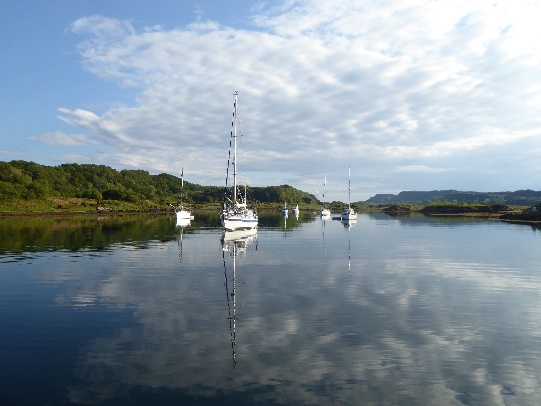 
Next on to Oban on a mission to acquire new fishing gear. Hopefully there will be more to report on this in the coming weeks…. Time for our first real passage – 44 miles across to and along the southern coast of Mull – culminating with the challenge of the Sound of Iona. Guidance in the pilot book made this appear somewhat daunting – a narrow and shallow route with numerous underwater rocks and a fast running tide - the Sound of Iona is quite a mess – somewhat incongruously presided over by the venerable pink granite abbey. However, at high water with only 10 knots of wind all went well – though we did see 2.1 m on the depth sounder at one point! Two large bottlenose dolphins joined us as we left the sound before heading round the Ross of Mull into our anchorage off the village of Bunessan - ready for visiting Iona and Staffa the next day. We spent the evening in sunshine looking across to the towering basalt terraces of the Ardmeanach Peninsula – the last we saw of the sun for some time. With a forecast of degenerating conditions, neither of the potential anchorages on Iona or Staffa would be secure enough for us to leave the boat to go ashore so we decided to use commercial alternatives.
Our trip to Staffa on Iolaire of Iona exceeded all expectations. The island is a staggering sight with basalt columns formed during intense volcanic activity 59 million years ago. Slow cooling of basaltic lava created the polygonal joint pattern of rock columns - exactly the same process as the Giant’s Causeway in Northern Ireland. Ashore we walked to top of island and wandered around the grassy clifftop sighting puffins, shags and guillemots. Then down to Fingal’s Cave – by chance, lucky to experience the cave entirely on our own – just to sit and gaze – awestruck and lost for words.  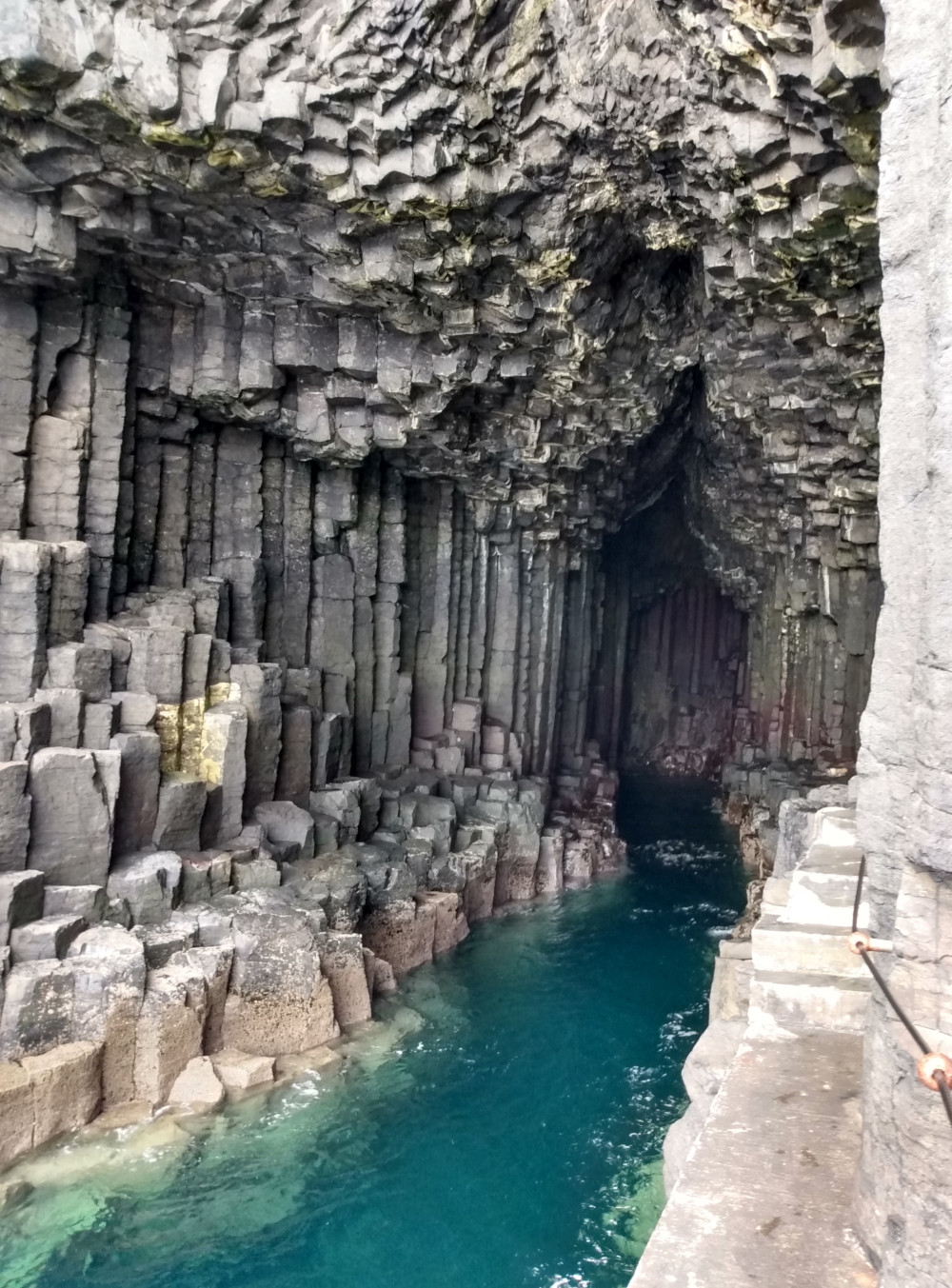
The following day we set off for Tobermory to get in ahead of the incoming tail end of Tropical Storm Alex. This was a wonderful sail of 25 miles under genny and mizzen, as unexpectedly aided by a knot of tide, we roared along at 7-8 knots, accompanied for a short while by a minke whale, passing Staffa again, the strangely shaped Treshnish Islands, Coll and Tiree appearing off on the port side, followed by Eigg and Muck and the impressive heights of Rum in the distance beyond Ardnmurchan Point, before rounding south down the Sound of Mull and into Tobermory – where we took the last available berth in the marina. A lucky and excellent day! The harbour was very full of yachts taking shelter from the gale – the perfect place to be - and as endearing as we remember it from our last visit 13 years ago. We spent a happy week generally chilling out – mentally and physically, indulging in the fleshpots of Tobermory – being the lively Mishnish pub, Tobermory Stores – superb deli, Café Fish for upmarket cuisine, and the availability of reliable internet! Going further afield we enjoyed some delightful walks, one in particular with good friends from home co-incidentally holidaying on Mull. 
However, all good things come to an end, though working out our next step proved a tricky process. Forecasts for conditions for onward progress to Coll, Berneray and Barra looked very unsettled with strong winds and changing directions - no chance of the four clear days we wanted. ‘the best laid plans o’ mice an’ men gang aft agley’ - after last year’s experience you might think we’d have known better than to think we’d be able to go wherever and whenever we wanted! Flexibility is key – so we changed plans, potentially to reverse the original route. Then the next time we checked the forecast, everything had changed again – back to Plan A? Keeping options open, we decided on the Small Isles and set off for Rum – the largest of these, in conditions which seemed initially to be brightening.
The false dawn of the previous forecast was replaced by a new one, facing us with a whole series of serious Atlantic lows set to blast through the Outer Hebrides, so next morning we set off to Mallaig, a more comfortable location to wait out the next one, expected imminently. The 16 mile beam reach to Mallaig was another good sail on a flat sea – despite scotch mist all the way and very poor visibility.
So we’re now in Mallaig where it isn’t raining absolutely all the time - yes, we know all of you in the south of the UK have been sweltering in unprecedented heat wave conditions!
Mallaig is a serious fishing port and we do love a good fishing port, so we’re not unhappy. Looking forward to hearing news from you … Julia and Chris |
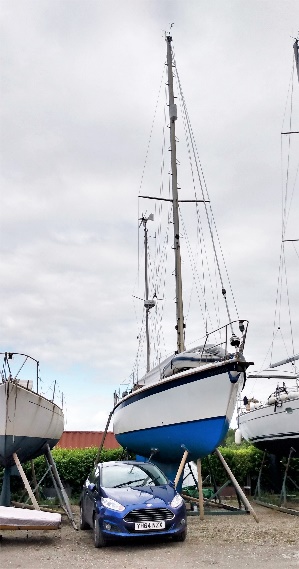 We travelled up for our annual rendezvous with Aremiti by car this time - an enjoyable and stress-free experience – unlike the hassle we usually face of taxis, coaches, flights and precision timings. Breaking the journey of just under 500 miles with a long overdue visit to old friends near Carlisle, was a very enjoyable bonus.
We travelled up for our annual rendezvous with Aremiti by car this time - an enjoyable and stress-free experience – unlike the hassle we usually face of taxis, coaches, flights and precision timings. Breaking the journey of just under 500 miles with a long overdue visit to old friends near Carlisle, was a very enjoyable bonus.
 After six days of windy showers we were nearing the end of our lists of jobs (it should be admitted here that our pre-circumnavigation jobs list was not finally cleared until we reached New Zealand!) The following day – 1st June – it was as if the switch had been flicked to summer, with a complete change in the weather to calm blue skies and sunshine. The blue hills beyond the marina started beckoning us out …
After six days of windy showers we were nearing the end of our lists of jobs (it should be admitted here that our pre-circumnavigation jobs list was not finally cleared until we reached New Zealand!) The following day – 1st June – it was as if the switch had been flicked to summer, with a complete change in the weather to calm blue skies and sunshine. The blue hills beyond the marina started beckoning us out …
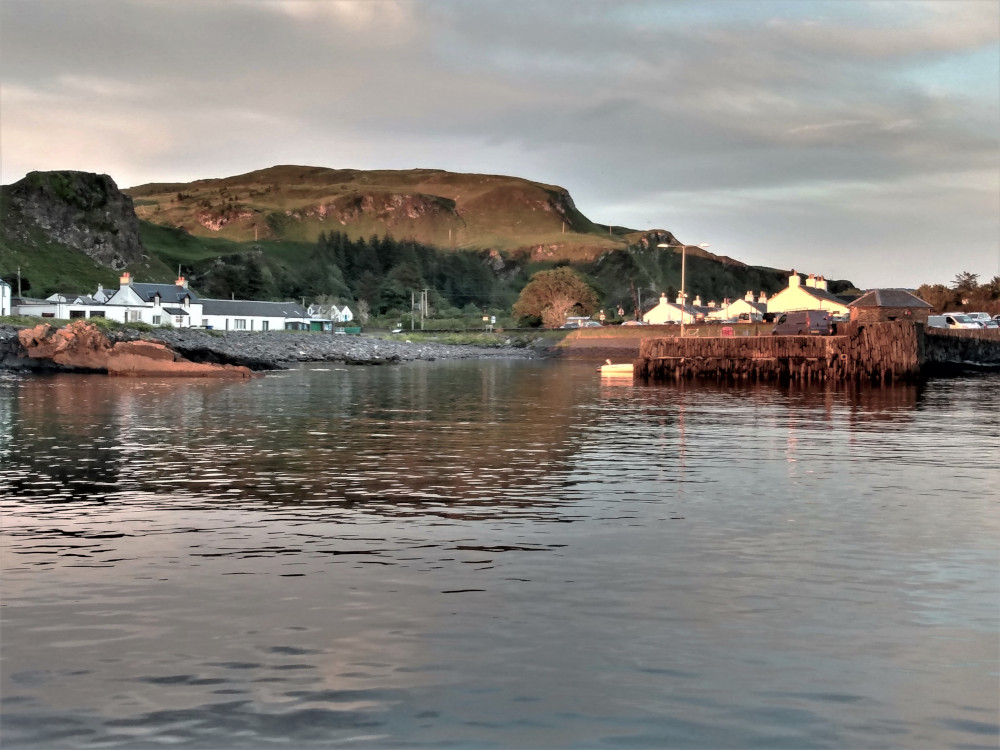 In the village of Ellenabeich on the Seil side of the sound were rows of quaint white terraced cottages – homes for the slate workers and a couple of water filled slate quarries.
The island of Easdale lies across the sound. Arriving in the tiny harbour the first sight is a row of wheelbarrows – ready for the inhabitants to pick up items brought over on the ferry. On our walk round the whole island – taking all of an hour - we found the same picturesque rows of cottages, a number of large water-filled slate quarries and numerous ruined slate sheds. With a population of 59 in 2011, risen from 16 in 1969, Easdale is now the most densely populated island in Scotland. Not only that - it holds the annual World Stone Skimming Championships!
In the village of Ellenabeich on the Seil side of the sound were rows of quaint white terraced cottages – homes for the slate workers and a couple of water filled slate quarries.
The island of Easdale lies across the sound. Arriving in the tiny harbour the first sight is a row of wheelbarrows – ready for the inhabitants to pick up items brought over on the ferry. On our walk round the whole island – taking all of an hour - we found the same picturesque rows of cottages, a number of large water-filled slate quarries and numerous ruined slate sheds. With a population of 59 in 2011, risen from 16 in 1969, Easdale is now the most densely populated island in Scotland. Not only that - it holds the annual World Stone Skimming Championships!
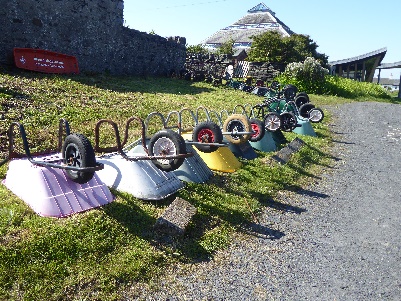

 A 10 minute bus ride to Fionnphort and short ferry crossing took us to Iona where we spent the morning walking out to the beautiful Traigh an t-Suidhe beach – despite overcast conditions - sparkling white sand and turquoise water – at the northern tip of the island and then to the highest point – Dun I (333 ft). Finally back to the port via the abbey and various ecclesiastical monuments and ruins. The island of Iona has been a major religious centre since St Columba landed there in 563. Despite relentless Viking attacks, a monastery was established which became the cathedral of the Bishops of the Isles. After the Reformation the centre fell into ruin until the 1930s, when it was restored as a centre of ecumenical worship and study. The abbey – dating back to 13th century has a dignified and spiritual feel to it – excellent little museum and tranquil cloisters.
A 10 minute bus ride to Fionnphort and short ferry crossing took us to Iona where we spent the morning walking out to the beautiful Traigh an t-Suidhe beach – despite overcast conditions - sparkling white sand and turquoise water – at the northern tip of the island and then to the highest point – Dun I (333 ft). Finally back to the port via the abbey and various ecclesiastical monuments and ruins. The island of Iona has been a major religious centre since St Columba landed there in 563. Despite relentless Viking attacks, a monastery was established which became the cathedral of the Bishops of the Isles. After the Reformation the centre fell into ruin until the 1930s, when it was restored as a centre of ecumenical worship and study. The abbey – dating back to 13th century has a dignified and spiritual feel to it – excellent little museum and tranquil cloisters.
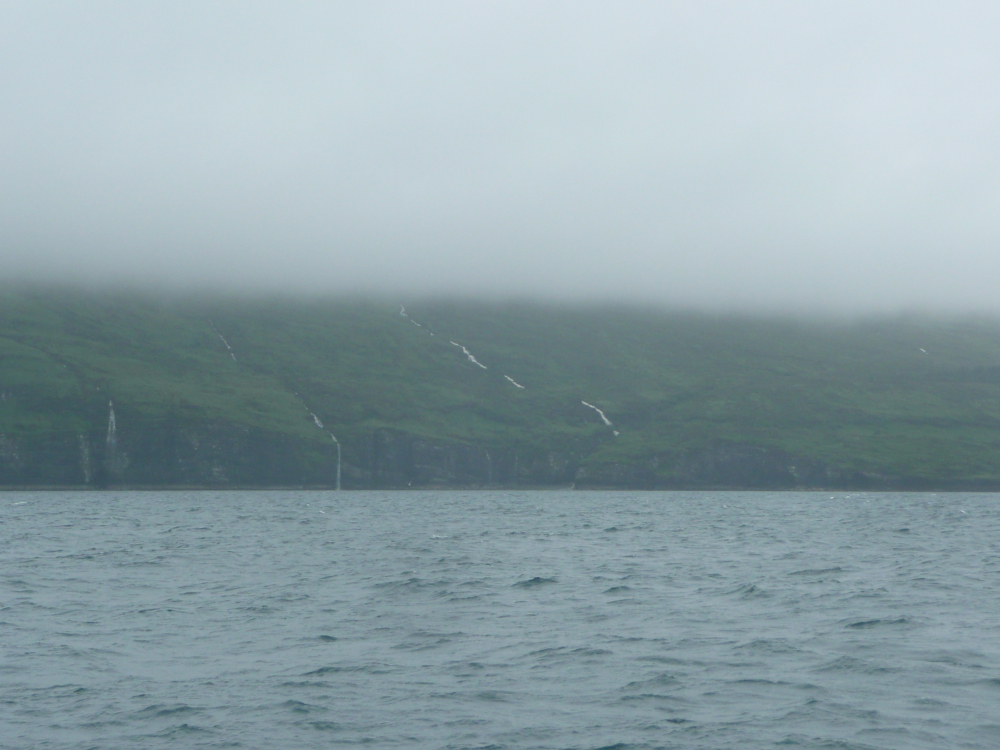 Passing Ardnamurchan Point – the most westerly point on the British mainland – felt a significant milestone as we made fast progress with wind behind us under genny and mizzen in a rather rolly sea. However, visibility was deteriorating as the ‘scotch mist’ increased, and as we passed by Muck and Eigg, we could hardly see Rum at all, never mind its majestic peaks. As we ran ¾ mile off along the rugged eastern side of the island – dominated by the Rum Cuillins, the highest part of the island - we could see only the lowest couple of hundred metres of steep coastline, just making out a number of impressive waterfalls plunging into the sea. On entering the inlet at Kinloch the wind seemed to blow extra hard, and it took several attempts to pick up a buoy. It seemed pointless to go ashore in the drenching and blowy conditions.
Passing Ardnamurchan Point – the most westerly point on the British mainland – felt a significant milestone as we made fast progress with wind behind us under genny and mizzen in a rather rolly sea. However, visibility was deteriorating as the ‘scotch mist’ increased, and as we passed by Muck and Eigg, we could hardly see Rum at all, never mind its majestic peaks. As we ran ¾ mile off along the rugged eastern side of the island – dominated by the Rum Cuillins, the highest part of the island - we could see only the lowest couple of hundred metres of steep coastline, just making out a number of impressive waterfalls plunging into the sea. On entering the inlet at Kinloch the wind seemed to blow extra hard, and it took several attempts to pick up a buoy. It seemed pointless to go ashore in the drenching and blowy conditions.

 It’s a bustling little village with enticing seafood eateries and the thriving ferry port transporting holidaymakers off to Skye, Knoydart, South Uist and the islands of Rum, Eigg, Muck and Canna.
So we’re now poised to head either west or north - who knows?
It’s a bustling little village with enticing seafood eateries and the thriving ferry port transporting holidaymakers off to Skye, Knoydart, South Uist and the islands of Rum, Eigg, Muck and Canna.
So we’re now poised to head either west or north - who knows?